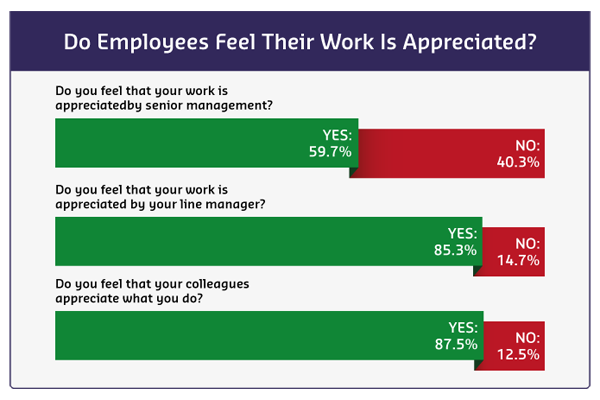Positive Trend in Employee Recognition
Milton Keynes (UK), March 2016 - Employers have capitalised on "good will" at the start of 2016 by better recognising staff members for their efforts, according to findings from a new survey from award-winning performance-improvement agency P&MM. The survey was conducted among 1,435 employees across 52 UK organisations between January and February 2016. It revealed that 87 percent of staff felt appreciated by their colleagues and 85 percent by their direct managers. However, the data also suggests that senior leaders are lagging behind in their recognition efforts, with only 57 percent feeling appreciated by senior management.
John Sylvester, Director at P&MM, comments, "The survey findings are a good barometer to highlight that employee recognition is now on the increase, and it is very encouraging. However, employers should not become complacent, as 20 percent of the workforce still feel undervalued by their immediate colleagues, which could equate to a 20 percent reduction in performance across the company. We must also consider the positive impact the festive season may have had on employee feelings toward their immediate colleagues. We often witness a strong end to the year from employers in their efforts to thank employees, but this quickly fades as the months pass. Maintaining momentum in recognition is essential to staff retention."
 According to an Oxford Economics report, it can cost up to £30,614 to replace a staff member. This includes the cost of advertising, agency fees, time invested in interviewing prospective candidates, and training them once they get started.
According to an Oxford Economics report, it can cost up to £30,614 to replace a staff member. This includes the cost of advertising, agency fees, time invested in interviewing prospective candidates, and training them once they get started.
Sylvester adds, "It is clear that senior leaders have much to do to bridge the divide between themselves and their teams ‘on the ground’. With belief in senior leadership a key factor in employee engagement, it is essential that c-suite executives take the time to recognize the efforts of their teams and not simply delegate this to line managers."
P&MM suggests seven steps to get a workforce motivated and performing at their best:
1. Create an engagement strategy. If you don’t have one, get one! Engaged employees are 20 times more likely to improve customer satisfaction and loyalty, productivity, turnover, and profit.
2. Implement a reward and recognition programme. If it is not possible to award pay increases, then consider non-cash incentives. Recognition of good work has been proven to be more effective at motivating staff against measurable criteria than salary levels. Cash incentives get lost among everyday bills, whereas non-cash rewards retain their presentation value.
3. Determine the behaviours you would like to see in your ideal employee and recognise those who display such behaviours. Recognition schemes can enhance organisational performance and improve profitability. By creating a culture of recognition within both managers and peers, you’ll motivate employees throughout the year.
4. Review your employee benefits. Benefits that add value to an employment package can have a genuine impact on the way employees view their employer. When salary freezes are commonplace, it is essential to offer staff other ways to make savings on their everyday spending and demonstrate that your organisation is helping them to cope with the ever increasing cost of living.
5. Make reward and recognition achievable by all, not just your top performers. Companies can achieve greater gains by ensuring that their reward programmes set targets based on performance improvement and can be attained by any member of staff, not just the top 10 percent.
6. Empower managers. Give managers the tools they need to create development programmes that evolve throughout the year. Don’t wait for the annual appraisal: use recognition-scheme data to give an indication of how well colleagues regard an individual, and act on this information accordingly. Only 58 percent of employees say they know what they are supposed to do and how their performance is assessed, so be sure to establish continual two-way dialogue.
7. Focus on measurement. How will you determine if all these initiatives have made a genuine impact on staff motivation, retention, and ultimately the success of the business? Forward-thinking enterprises increasingly look for qualitative measurements of the success of their motivation programmes, such as customer-satisfaction surveys and feedback from mystery shoppers or colleagues, including non-customer-facing staff.









